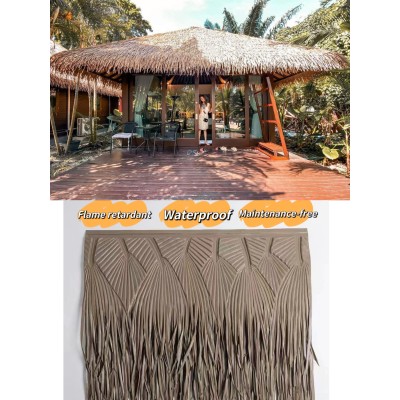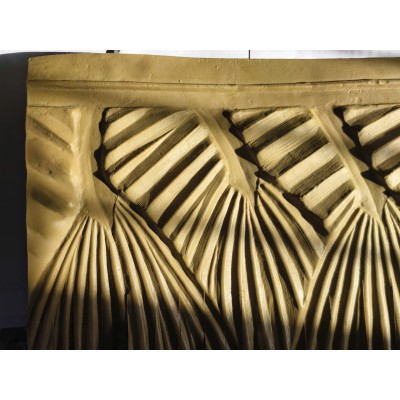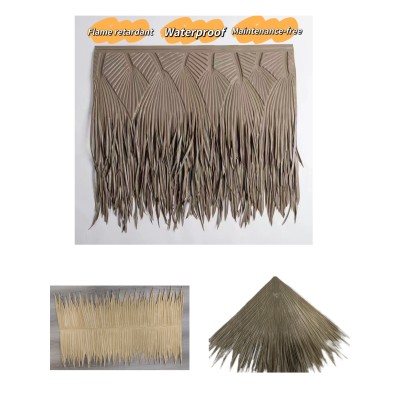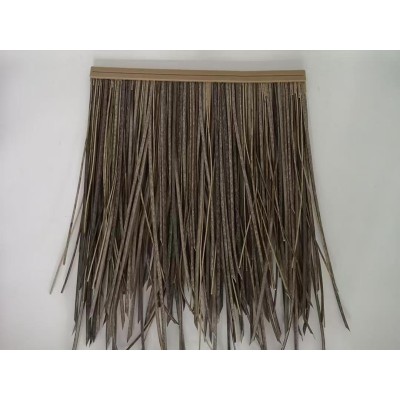How to replace a Bahay Kubo roof with synthetic Nipa gum
How to replace a Bahay Kubo roof with synthetic Nipa gum
Nypa fruticans (Nypa fruticans) is a national key second-class protected wild plant in China, and it is prohibited to illegally collect, trade, purchase, process national protected wild plants or destroy their growing environment, so its synthetic Nipa thatch is used for roof replacement and other behaviors.
"Bahay Kubo" is a traditional tall house in the Philippines, and for the replacement of the roof of this type of house, if the use of legal materials, such as synthetic palm thatch (such as synthetic palm thatch and synthetic thatch roofing materials commonly used for roofing), the general steps are as follows:
First, what is the application of synthetic Nipa roof:
1. Restoration and reconstruction of traditional buildings
In some Southeast Asian regions, traditional buildings such as Bahay Kubo (a traditional Filipino tall house) may have previously used natural materials such as Nipah leaves as roofs. Synthetic Nipah roofing materials can be used as an alternative to natural Nipah materials for the restoration and reconstruction of these traditional buildings. This is because the availability of natural Nipah materials may be limited by seasonal, environmental and other factors, and their durability may be limited. Synthetic Nipah roofing materials can simulate the appearance and partial performance of natural Nipah to a certain extent, while having better supply stability, and can maintain the style of traditional buildings.
2. Waterproof function application
Synthetic Nipah roofing materials usually have good water resistance. It can effectively prevent rain from penetrating into the interior of the house, and is very suitable for some simple houses, temporary buildings or storage buildings with high waterproof requirements. For example, in some rural warehouses or simple tool houses, the use of synthetic Nipah roofs can reduce construction costs while ensuring the waterproof function of the roof.
3. Heat insulation advantages
This material can provide some insulation. In hot climates, it can block the introduction of solar radiant heat into the room and reduce the rise of indoor temperature. This is especially important for buildings in the tropics. For example, in some small residential or tourist facilities on tropical islands, the use of synthetic Nipah roofs can improve indoor thermal comfort and reduce the use of refrigeration equipment such as air conditioning, thus achieving the purpose of energy saving.
4. Aesthetic and cultural value
Synthetic Nipah roofing materials can be designed to have the natural texture and color of Nipah leaf, which has a unique aesthetic in appearance. It can be used in some landscape architecture or cultural theme architecture to reflect the local cultural characteristics. For example, in some resorts or folk museums with Southeast Asian culture as the theme, synthetic Nipa roof can create a strong regional cultural atmosphere.
5. Durability and easy maintenance
Synthetic Nipah roofing materials are generally more durable than natural Nipah leaves. It can resist the damage of natural factors such as wind and rain erosion and ultraviolet radiation, and has a long service life. And in terms of maintenance, synthetic Nipah roofing materials are usually easier to clean, when the surface has dust, dirt, etc., only need a simple rinse or wipe, do not need to carry out complex anti-corrosion, insect protection and other treatment like natural materials.
Second, how is the environmental protection of synthetic Nipah roofing material?
The following is an analysis of the environmental protection of synthetic Nipah roofing materials:
1. Environmental protection of the production process
Raw material perspective: If the main components of synthetic Nipah roof materials are common polymer polymers such as synthetic resins, their sources are usually relatively stable, and some raw materials can be obtained through artificial synthesis, reducing the dependence on natural resources. And in the selection of additives and auxiliaries, if the selection of non-toxic, harmless, degradable environmentally friendly auxiliaries, can further improve the environmental performance of the material.
Energy consumption and pollution emission: In the process of producing synthetic Nipah roofing materials, if advanced production processes and equipment are used, energy consumption and pollutant emission can be effectively reduced. For example, some modern production lines improve production efficiency by optimizing the process parameters of heating, extrusion, cooling and other links, and reduce the discharge of waste gas, wastewater, and waste residue.
2. Environmental protection in the use process
Durability and resource saving: Synthetic Nipah roofing materials usually have good durability, can resist wind and rain erosion, ultraviolet radiation and other natural factors of damage, long service life. This means that roofing materials do not need to be changed frequently over a longer period of time, thus reducing resource consumption and waste generation due to frequent material changes.
Heat insulation and energy saving effect: the material generally has a certain heat insulation performance, which can block the solar radiant heat into the room and reduce the rise of indoor temperature. In summer, it can reduce the frequency of use of indoor air conditioning and reduce energy consumption; In winter, it can reduce the loss of indoor heat to a certain extent and play a role in energy saving.
3. Environmental protection after waste
Recyclability: Some synthetic Nipah roofing materials can be recycled after waste and reprocessed into new building materials or other products to realize the recycling of resources and reduce the pressure on the environment. For example, some synthetic resin tiles can be broken and melted into new resin products through a specific recycling process after use.
Biodegradability: Although the degradation of synthetic materials is generally more difficult than that of natural materials, some current research is devoted to the development of biodegradable synthetic Nipah roofing materials. If degradable components are added to the synthesis process of materials or degradable polymers are used as substrates, then these materials may gradually degrade in the natural environment after waste, reducing the long-term impact on the environment.
Three, the different choices of synthetic Nipa thatch roof
1. Design selection
Synthetic Palm Roof: The leaves of this thatch are large and fluffy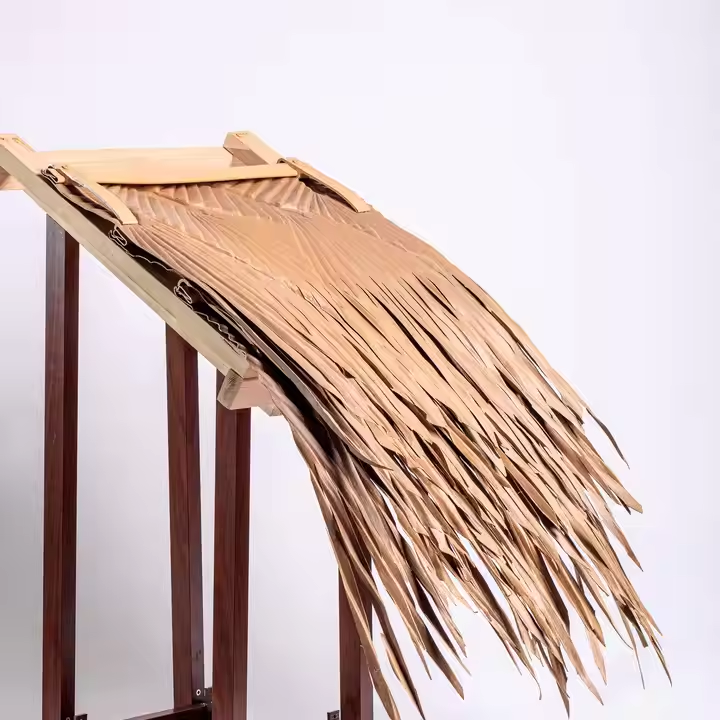
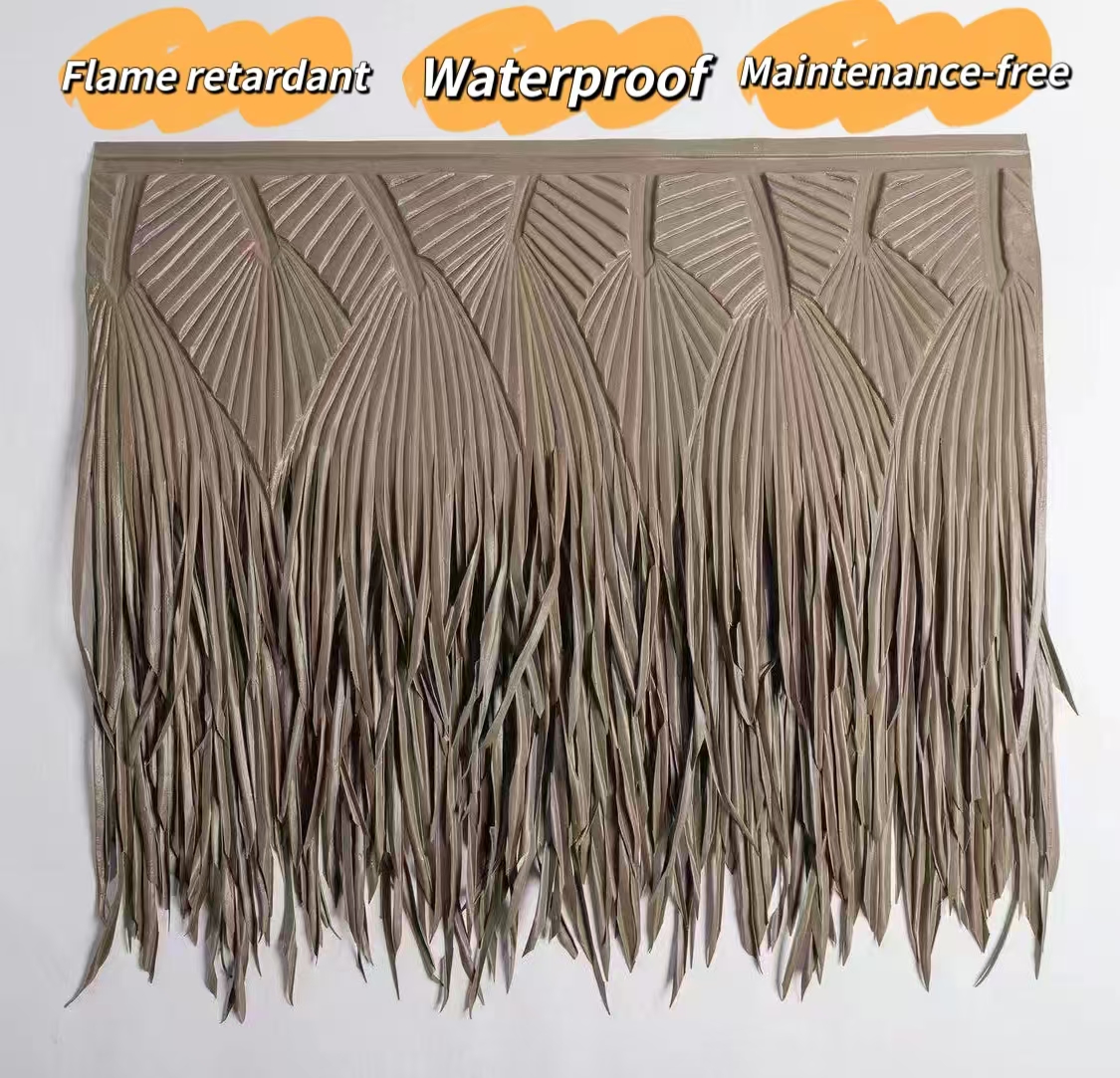
Synthetic thatch: This type of thatch has smaller leaves and looks straight.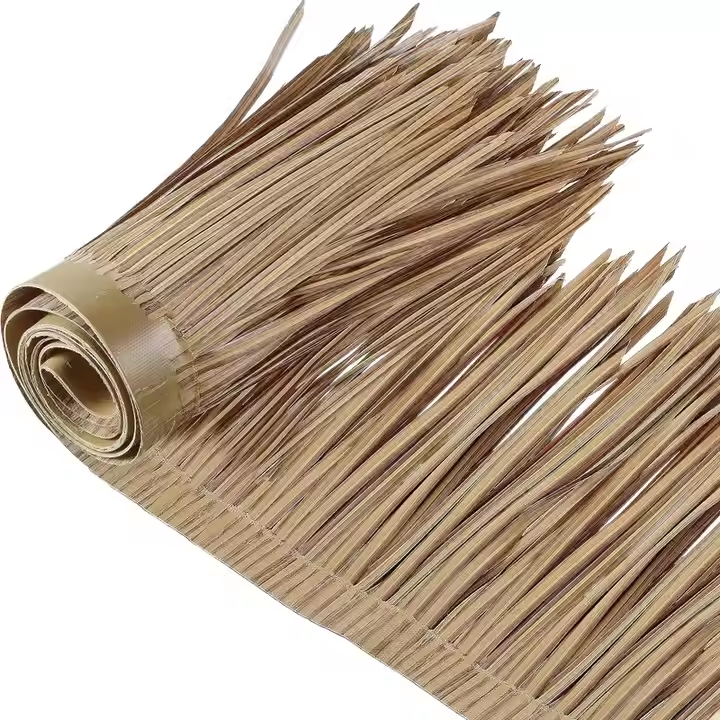
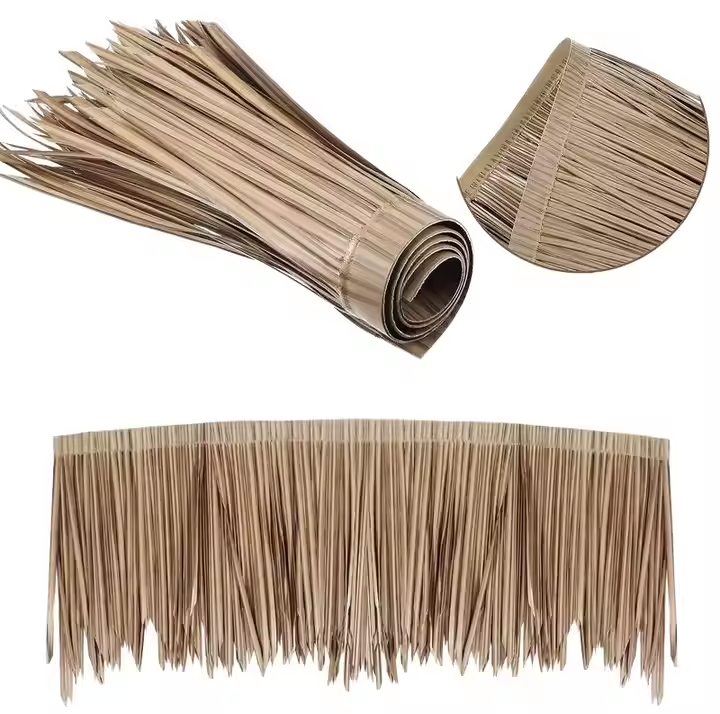
2. Color diversity:
Synthetic Nipa thatch roofing material is available in a variety of colors. In addition to simulating the primary colors of natural Nipa thatch (such as light yellow, hazel, etc.), other colors can be selected according to architectural style and personal preference. For example, for some resort buildings with tropical flavor, you can choose bright green synthetic thatch to make the building more dynamic; For the restoration of some traditional buildings that pursue a simple style, it is more appropriate to choose the earth yellow or gray white synthetic thatch that is close to nature.
3. Texture and length variations:
In terms of texture, some synthetic thatch has a smooth surface, mimicking the finely treated Nipah thatch; Others have a rough texture, closer to the texture of the original natural thatch. In terms of length, materials can provide different specifications. Short thatch may be more suitable for roofs with smaller slopes, while long thatch can be used to create a more fluffy and natural roof effect. For example, long thatch can be used on the roofs of some large landscape buildings or cultural exhibition buildings, which can enhance the visual impact of the buildings.
Four, different installation methods
1. Nail mounted synthetic thatch:
This installation is done by attaching synthetic thatch to the base structure of the roof through nails. Its advantage is that it is firmly installed and can withstand external forces such as large wind. In the installation process, it is necessary to first fix the base structure (such as boards, wood strips, etc.) on the frame of the roof, and then nail the synthetic thatch piece by piece on the base structure. Nail mounted synthetic thatch is suitable for use in areas where the roof slope is large or where there is often bad weather (such as typhoons, heavy rains, etc.).
2. Bundled synthetic thatch:
Bundling is the use of ropes to secure synthetic thatch to the roof frame. Its advantage is that the installation method is more flexible, there is no need to punch holes in the synthetic thatch, and it will not affect the integrity of the thatch. And rope binding can better simulate the way natural thatch is fixed, making the roof look more natural. However, this method may be slightly less firm than the nail-mounted type, and is more suitable for the built environment with higher appearance requirements, smaller roof slope and smaller wind.
3. Pasted synthetic thatch:
Paste is the use of special glue to paste synthetic thatch on the roof base. This way the installation speed is relatively fast, and the synthetic thatch can be more closely fitted with the base structure, which can effectively prevent rain leakage. However, it has high quality requirements for glue, and it is necessary to choose a glue with good weather resistance and bond strength. At the same time, during the installation process, pay attention to the uniformity of the glue to avoid the phenomenon of empty drums, which is generally suitable for small buildings or local roof repair.
Synthetic Nipa wooden roof Synthetic Nipa thatch Bahay Kubo roof replacement
